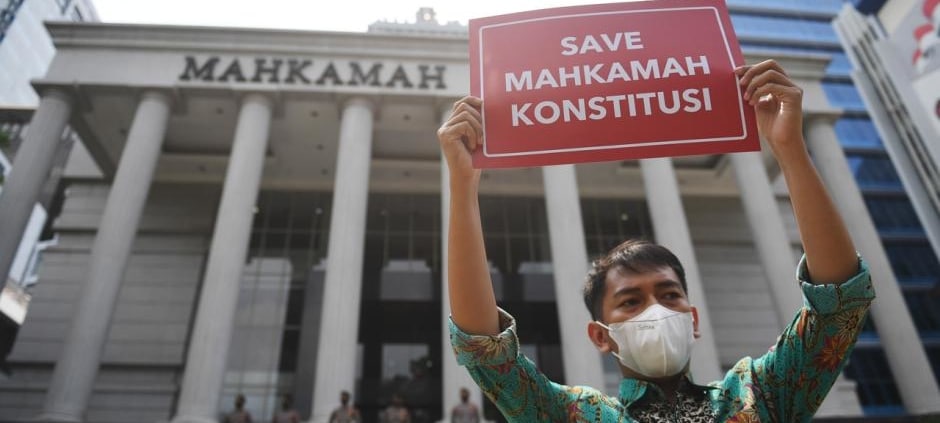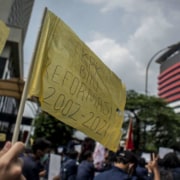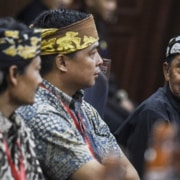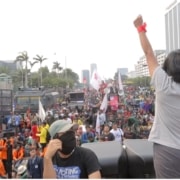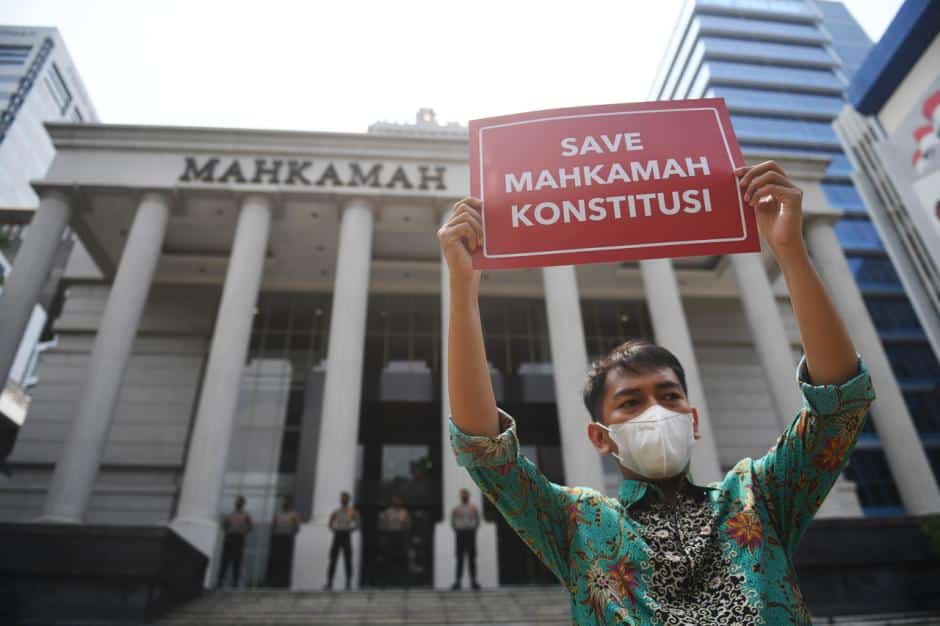
Activists protested outside the Constitutional Court on 4 October. Photo by Akbar Nugroho Gumay for Antara.
On 29 September, Commission III of the House of Representatives (DPR) agreed to nominate Guntur Hamzah as one of the nine judges of the Constitutional Court. This decision seemed to come out of nowhere, and immediately caused uproar in the Indonesian legal community.
For the DPR to nominate a new judge to the court, one of the three judges previously nominated by the DPR would have had to have died, finished their tenure, quit, or been sacked. Otherwise, this would result in 10 judges sitting on the court, which would violate the terms of the Constitution.
It soon emerged that the DPR intended Guntur to replace Constitutional Court Deputy Chief Justice Aswanto, who, according to the 2020 amendments to the Law on the Constitutional Court, was supposed to serve until 2029.
The DPR had apparently decided to replace Aswanto for failing to defend the interests of the DPR – and daring to invalidate laws produced by the DPR – while serving on the Court. Head of DPR Commission III Bambang Wuryanto said that Aswanto was nominated as a judge by the DPR and, as such, he must represent and protect its interests. If his performance was “unsatisfactory”, Bambang said, the DPR had the right to recall him.
This is a shocking and unconstitutional development that undermines judicial independence, and even threatens the existence of the Constitutional Court as a guardian of democracy.
The Constitution and the Law on the Constitutional Court (Law No. 24 of 2003, as amended by Law No. 7 of 2020) clearly regulate appointment and dismissal of Constitutional Court judges. Both state that the court is comprised of nine judges, with the DPR, Supreme Court and the president responsible for nominating three each, who are then formally appointed by the president. According to Law No. 24 of 2003, the nomination process is left up to each institution but it must be “transparent and participatory” (Article 19) and “objective and accountable” (Article 18(1)).
Meanwhile, the procedures for dismissal of judges are quite different, and are outlined under Articles 23-27A. The law states that it is the Constitutional Court that is responsible for setting the conditions for dismissal of judges, not any other institution. These provisions are designed precisely to ensure that the court remains independent by preventing judges being dismissed arbitrarily by other institutions.
The Law also states that the Constitutional Court must inform the relevant institutions six months before a judge reaches retirement age (Article 26(1)). The court sent no such letter to the DPR in respect of Aswanto. But it did send a different letter, which the DPR has used to justify its highly questionable actions.
On 21 July, the Constitutional Court wrote to the president, DPR and Supreme Court, notifying ththem of its decision in a judicial review of the Law on the Constitutional Court.
This judicial review petition was submitted by a lawyer, Priyanto, who felt that the 2020 amendments to the Law on the Constitutional Court could unfairly prevent him from becoming a judge on the court. Notably, the 2020 amendments raised the minimum age for prospective judges to 55 from 47, and increased the terms of the chief justice and deputy chief justice of the Constitutional Court from 2.5 to 5 years. They also removed the previous maximum tenure period of two five-year terms for all sitting judges.
Priyanto challenged Article 87(a), which states that judges currently serving as head or deputy head of the Constitutional Court can hold that position until their term as head or deputy ends, and 87(b), which states that judges serving at the time the law was enacted are considered to fulfil the requirements to serve on the court, and can remain on the bench until they reach the retirement age of 70 (as long as they have not served for more than 15 years). The effect of Article 87(b), Priyanto argued, was that it reduced opportunities for him to be selected as a judge.
In hearing the challenge, the court granted part of Priyanto’s challenge, stating that Article 87(a) was unconstitutional and therefore invalid. But it did not revoke Article 87(b). It said that this article was intended only to aid transition from the old law to the revised law, and was not designed to privilege certain individuals currently sitting on the bench. To clarify this point, the court felt it necessary to send a formal letter to the DPR, Supreme Court and president, confirming that term limits would no longer apply to judges currently on the bench.
But the DPR appears to have used this letter as an excuse to propose dismissing Aswanto (who, recall, was serving as deputy chief justice) and replace him with Guntur Hamzah.
The three judges now serving on the Constitutional Court who were put forward by the DPR are Arief Hidayat, Wahiduddin Adams and Aswanto. Of the three, Wahiduddin is set to reach the end of his term first, in March 2024 – Aswanto was not due for retirement until 2029.
It is suspected that Aswanto was selected for dismissal because he had ruled in favour of challenges to laws that the DPR and government considered strategic. In particular, the Constitutional Court’s December 2021 ruling that the Omnibus Law on Job Creation was procedurally flawed caused considerable consternation among lawmakers and government officials.
Apparently, the fact that the DPR’s pick would do this was seen by DPR members as unconscionable – especially given the fact that the DPR felt it had already given the Constitutional Court judges a “gift”, by removing their term limits, and allowing them to serve until they were 70.
A sign of the DPR and government’s anger is the fact that they are now planning a further amendment to the Law on the Constitutional Court. This will include new provisions that allow for evaluation of serving judges every five years by the institutions that proposed them, or at any time in response to complaints. This evaluation is then submitted to the Constitutional Court.
If these revisions are enacted, judges sitting on the court will be placed under extraordinary pressure, with the threat of being “recalled” constantly hanging over their heads.
Judicial independence is guaranteed under Article 24 of the Constitution. How can judges work independently if they are liable to be evaluated at any time, based simply on a report or complaint from the community? The proposed revisions should be abandoned immediately.
The draft revisions to the Law on the Constitutional Court are still set to be deliberated by the DPR and government. But it is clear the spirit of the proposed changes has already influenced Commission III in its decision to recall Aswanto.
As the first chief justice of the Constitutional Court from 2003-2008, I have been asked to respond to Aswanto’s dismissal. When media approached me on the day it occurred, 29 September, I stated clearly that it was a decision that violated the Constitution and applicable law.
On 1 October, I convened a meeting of nine former Constitutional Court judges, including three former chief justices – myself, Hamdan Zoelva, and Coordinating Minister for Political, Legal and Security Affairs Mahfud MD. Others present were Laica Marzuki, Maruarar Siahaan, Harjono, Ahmad Sodiki, Maria Farida, and I Gede Dewa Palguna. The meeting concluded that the DPR’s decision to nominate Guntur Hamzah to replace Aswanto violated the Constitution and the law, and was a deliberate misinterpretation of the letter sent by the Constitutional Court in July.
The DPR only has the authority to nominate prospective judges to the court, it has no power to dismiss judges in the middle of their tenure. It has clearly overstepped its authority, destroying the independence of the Constitutional Court, and indeed the rule of law, in the process.
The president must not sign off on Aswanto’s dismissal. A new judge should only be appointed when one of the positions becomes vacant, in accordance with the law.
This piece has been translated and edited by Indonesia at Melbourne from the original Indonesian.


